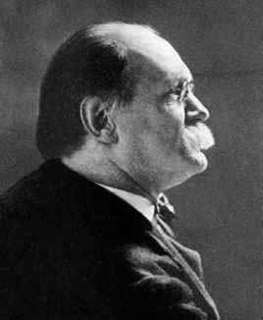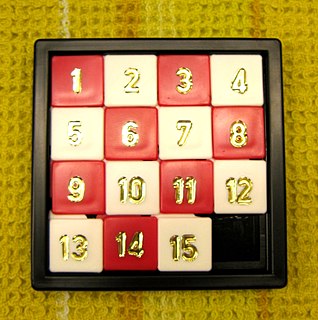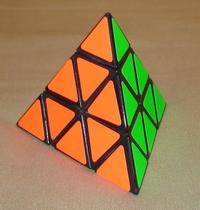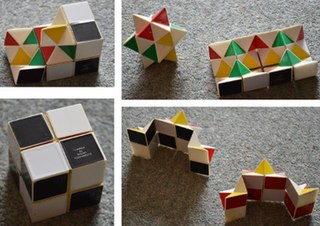Related Research Articles

Recreational mathematics is mathematics carried out for recreation (entertainment) rather than as a strictly research and application-based professional activity or as a part of a student's formal education. Although it is not necessarily limited to being an endeavor for amateurs, many topics in this field require no knowledge of advanced mathematics. Recreational mathematics involves mathematical puzzles and games, often appealing to children and untrained adults, inspiring their further study of the subject.

Samuel Loyd, was an American chess player, chess composer, puzzle author, and recreational mathematician. Loyd was born in Philadelphia but raised in New York City.

The tangram is a dissection puzzle consisting of seven flat polygons, called tans, which are put together to form shapes. The objective is to replicate a pattern generally found in a puzzle book using all seven pieces without overlap. Alternatively the tans can be used to create original minimalist designs that are either appreciated for their inherent aesthetic merits or as the basis for challenging others to replicate its outline. It is reputed to have been invented in China sometime around the late 18th century and then carried over to America and Europe by trading ships shortly after. It became very popular in Europe for a time, and then again during World War I. It is one of the most widely recognized dissection puzzles in the world and has been used for various purposes including amusement, art, and education.

A mechanical puzzle is a puzzle presented as a set of mechanically interlinked pieces in which the solution is to manipulate the whole object or parts of it. One of the most well-known mechanical puzzles is the Rubik's Cube, invented by the Hungarian architect Ernő Rubik in 1974. The puzzles are mostly designed for a single player where the goal is for the player to see through the principle of the object, not so much that they accidentally come up with the right solution through trial and error. With this in mind, they are often used as an intelligence test or in problem solving training.

Disentanglement puzzles are a type or group of mechanical puzzle that involves disentangling one piece or set of pieces from another piece or set of pieces. Several subtypes are included under this category, the names of which are sometimes used synonymously for the group: wire puzzles; nail puzzles; ring-and-string puzzles; et al. Although the initial object is disentanglement, the reverse problem of reassembling the puzzle can be as hard as—or even harder than—disentanglement. There are several different kinds of disentanglement puzzles, though a single puzzle may incorporate several of these features.

A burr puzzle is an interlocking puzzle consisting of notched sticks, combined to make one three-dimensional, usually symmetrical unit. These puzzles are traditionally made of wood, but versions made of plastic or metal can also be found. Quality burr puzzles are usually precision-made for easy sliding and accurate fitting of the pieces. In recent years the definition of "burr" is expanding, as puzzle designers use this name for puzzles not necessarily of stick-based pieces.

The 15 puzzle is a sliding puzzle having 15 square tiles numbered 1–15 in a frame that is 4 tiles high and 4 tiles wide, leaving one unoccupied tile position. Tiles in the same row or column of the open position can be moved by sliding them horizontally or vertically, respectively. The goal of the puzzle is to place the tiles in numerical order.

Nobuyuki Yoshigahara was perhaps Japan's most celebrated inventor, collector, solver, and communicator of puzzles.

Jerry Slocum is an American historian, collector and author specializing on the field of mechanical puzzles. He worked as an engineer at Hughes Aircraft prior to retiring and dedicating his life to puzzles.
A dissection puzzle, also called a transformation puzzle or Richter Puzzle, is a tiling puzzle where a set of pieces can be assembled in different ways to produce two or more distinct geometric shapes. The creation of new dissection puzzles is also considered to be a type of dissection puzzle. Puzzles may include various restraints, such as hinged pieces, pieces that can fold, or pieces that can twist. Creators of new dissection puzzles emphasize using a minimum number of pieces, or creating novel situations, such as ensuring that every piece connects to another with a hinge.

A sliding puzzle, sliding block puzzle, or sliding tile puzzle is a combination puzzle that challenges a player to slide pieces along certain routes to establish a certain end-configuration. The pieces to be moved may consist of simple shapes, or they may be imprinted with colours, patterns, sections of a larger picture, numbers, or letters.

Uwe Mèffert was a German puzzle designer and inventor. He manufactured and sold mechanical puzzles in the style of Rubik's Cube since the Cube craze of the 1980s. His first design was the Pyraminx – which he had developed before the original Rubik's cube was invented. He created his own puzzle company and helped bring to market the Megaminx, Skewb, Skewb Diamond and many other puzzles.

The T puzzle is a tiling puzzle consisting of four polygonal shapes which can be put together to form a capital T. The four pieces are usually one isosceles right triangle, two right trapezoids and an irregular shaped pentagon. Despite its apparent simplicity, it is a surprisingly hard puzzle of which the crux is the positioning of the irregular shaped piece. The earliest T puzzles date from around 1900 and were distributed as promotional giveaways. From the 1920s wooden specimen were produced and made available commercially. Most T puzzles come with a leaflet with additional figures to be constructed. Which shapes can be formed depends on the relative proportions of the different pieces.

A combination puzzle, also known as a sequential move puzzle, is a puzzle which consists of a set of pieces which can be manipulated into different combinations by a group of operations. Many such puzzles are mechanical puzzles of polyhedral shape, consisting of multiple layers of pieces along each axis which can rotate independently of each other. Collectively known as twisty puzzles, the archetype of this kind of puzzle is the Rubik's Cube. Each rotating side is usually marked with different colours, intended to be scrambled, then 'solved' by a sequence of moves that sort the facets by colour. As a generalisation, combination puzzles also include mathematically defined examples that have not been, or are impossible to, physically construct.

The Yoshimoto Cube is a polyhedral mechanical puzzle toy invented in 1971 by Naoki Yoshimoto, who discovered that two stellated rhombic dodecahedra could be pieced together into a cube when he was finding different ways he could split a cube equally in half. Yoshimoto first introduced his cube in 1972 at a solo exhibition entitled "From Cube to Space", and later developed three commercial versions. In 1982, Yoshimoto Cube No. 1 was included in the Museum of Modern Art's permanent collection.
Panagiotis Verdes is a Greek inventor and is known for being the first person to mass produce 6x6x6 puzzles and 7x7x7 twisty puzzles. He is also known for founding the company V-Cube. He has also worked on new designs of every Twisty Puzzle from 2x2x2 to 11x11x11.

IRONCAD is a software product for 3D and 2D CAD (computer-aided-design) design focused mainly on the mechanical design market that runs on Microsoft Windows. It is developed by Atlanta, GA based IronCAD LLC.
Willie Young is a 20th-century American artist. Young is mainly self-taught, and his work has been exhibited alongside other prominent outsider artists, such as Bill Traylor, Nellie Mae Rowe and Thornton Dial. The main body of his work consists of delicately rendered graphite drawings.

Commodore Laurence Phillip Brokenshire CBE (1952–2017), known as Laurie Brokenshire, was a Royal Naval officer, magician, and world-class puzzle solver. He is also known to have successfully fostered over 70 children in 22 years.

Hexastix is a symmetric arrangement of non-intersecting prisms, that when extended infinitely, fill exactly 3/4 of space. The prisms in a hexastix arrangement are all parallel to 4 directions on the body-centered cubic lattice. In The Symmetries of Things, John Horton Conway, Heidi Burgiel, and Chaim Goodman-Strauss named this structure hexastix.
References
- 1 2 Ford, Matt (24 February 2008). "AAAS: Design of Mechanical Puzzles". Ars Technica. Conde Nast. Retrieved 14 July 2015.
- 1 2 3 4 5 6 7 8 9 Beaulieu, Angie (7 December 2007). "The Man Behind the Puzzles". Eagle-Tribune. Retrieved 14 July 2015– via The Norman Transcript.
- 1 2 Smith, Linda C. (2008). "Book Marks". UMASS Amherst. Archived from the original on 22 November 2015. Retrieved 14 July 2015.
- 1 2 3 4 5 6 Coffin, Stewart T. (December 2000). Ap-Art: The Sculptural Art That Comes Apart (PDF). p. 1. Retrieved 14 July 2015.
- ↑ Pletcher, Brian (7 February 2010). "Stewart Coffin Visit". Brian's Damn Puzzle Blog.
- ↑ USpatent 3721448,Coffin, Stewart T.,"Assembly Puzzle",published 1973-03-20
- ↑ Storer, Jim. "Hectix". Jim Storer. The Brandeis Computer Science Department. Retrieved 14 July 2015.
- 1 2 Rausch, John. "Stewart Coffin". Puzzle World. Retrieved 14 July 2015.
- 1 2 Kirsch, Elisabeth (10 May 2015). "The Kansas City Star" . Retrieved 14 July 2015.
- ↑ Slocum, Jerry. "Mechanical Puzzles Exhibit at the Katonah Museum of Art, 2000-2001". Association of Game and Puzzle Collectors. Archived from the original on 5 September 2015. Retrieved 14 July 2015.
- ↑ Zimmer, William (12 November 2000). "Art Review; Delectable Puzzlements". The New York Times. Retrieved 14 July 2015.
- ↑ Association Awards: Sam Loyd Award Association for Games & Puzzles International